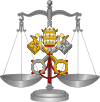Congregation of diocesan right
A Congregation of diocesan right (or Institute of diocesan right) is a type of religious congregation codified by the laws of the Catholic church, wherein the congregation is under the authority of a particular local bishop, rather than that of the pope. A congregation responsible directly to the pope is a congregation of pontifical right. Most of the major religious orders are congregations of pontifical right.[1]
 |
| Part of a series on the |
| Canon law of the Catholic Church |
|---|
|
Jus antiquum (c. 33-1140)
Jus novum (c. 1140-1563) Jus novissimum (c. 1563-1918) Jus codicis (1918-present) Other |
|
Sacraments
Sacred places
Sacred times |
|
|
Supreme authority, particular churches, and canonical structures Supreme authority of the Church
Supra-diocesan/eparchal structures
|
|
|
Temporal goods (property) |
|
Canonical documents |
|
Procedural law Pars statica (tribunals & ministers/parties)
Pars dynamica (trial procedure)
Election of the Roman Pontiff |
|
Legal practice and scholarship
Academic degrees Journals and Professional Societies Faculties of canon law
Canonists |
|
|
The major types of religious associations recognized by canon law are:
1. Public Association of the Faithful[2]
2. Institutes of Consecrated Life
- a. Institute of diocesan right
- b. Institute of pontifical right
References
- Code of Canon law, Canon 589 Archived April 18, 2016, at the Wayback Machine, accessed 18 August 2012.
- Code of Canon law, Associations of the faithful, accessed 18 August 2012.